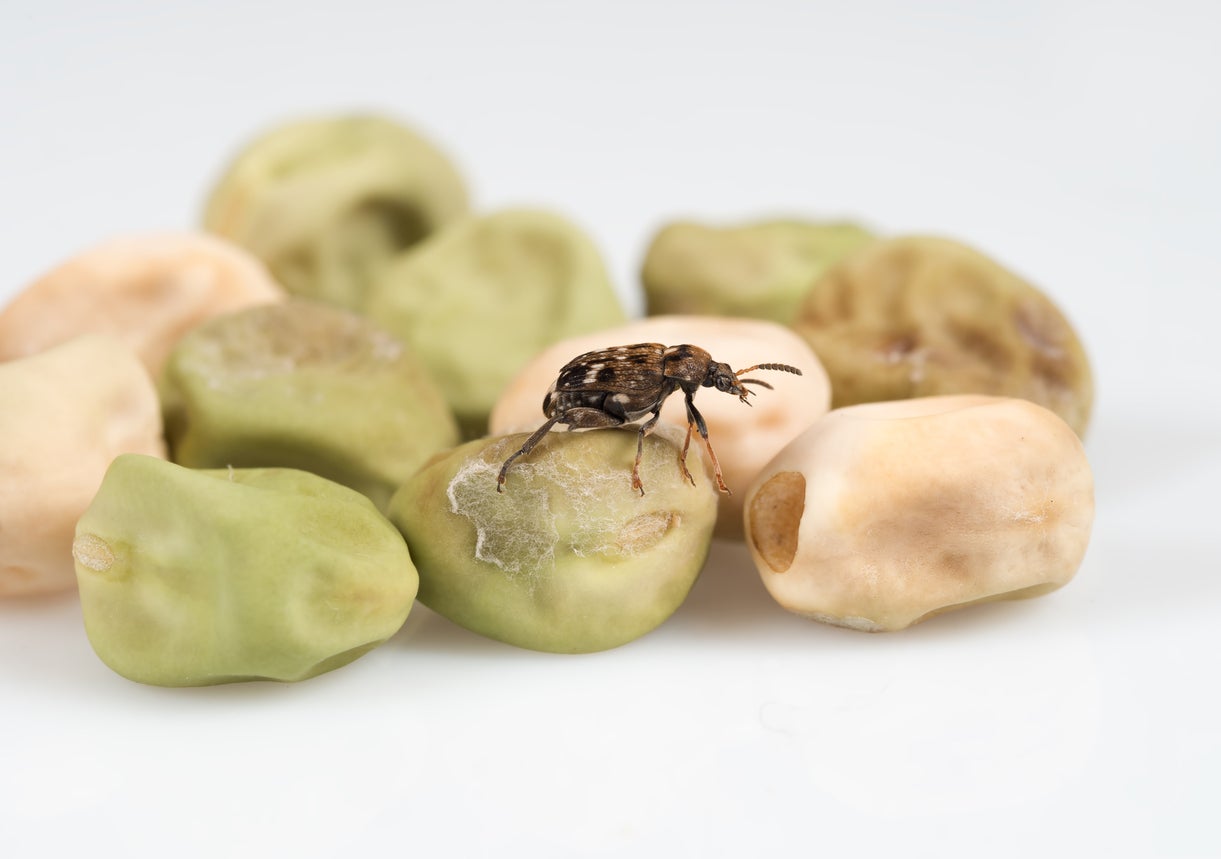What Are Pea Weevils: Information For Control Of Pea Weevil Pests

Does something seem amiss with your pea crop? Perhaps you have noticed insects feeding on the blossoms or tiny eggs on the pea pods. If so, the culprits are very likely pea weevil pests. Pea weevil damage is a major menace to pea production, specifically to garden and canning peas. What are pea weevils, anyway? Keep reading to find out.
What are Pea Weevils?
Pea weevil pests are small, black to brownish insects with a white zigzag running across the back. Bruchus pisorum overwinter in plant debris in the soil and then lay their eggs on the pea pods. Pea weevil larvae hatch and burrow into the pods and feed on the developing peas while adults munch on the blossoms. The resulting pea weevil damage on the pea crop renders it unfit for sale in the commercial sector and unappetizing for the home gardener. Not only does this pea weevil infestation affect the germination potential of developing peas, but in the commercial arena, costs many dollars separating and discarding infested pea pods.
Control of Pea Weevil
The control of pea weevil pest is of paramount importance in relation to the commercial pea crop industry and it may be of a high importance to the home gardener as well. Controlling pea weevils in the pea farm may be attained with the use of a dust mixture containing ¾ of 1 percent of rotenone. One to three dustings may be necessary to gain the upper hand on the pea weevil infestation at just the correct life cycle of the pea. The primary dusting should occur when the peas first begin to bloom, but before pods have set. Successive application should occur depending upon weevil migrations that may afflict the field after the first rotenone application. This same dusting procedure will work in the home garden with a hand duster and should be repeated at weekly intervals throughout the growing season. For the home gardener, however, the first order of business when controlling pea weevil infestations is to clean and dispose of any debris in the garden where the pests can potentially overwinter. Spent vines should be pulled and destroyed immediately post-harvest. The pulling of the vines before the peas are dry is the wisest course of action, although piling and burning will work just as well. Any that are left in the garden should be plowed underground 6-8 inches (15-20 cm.). This practice will prevent any eggs deposited from hatching or developing and infesting the pea crop the following year.
Gardening tips, videos, info and more delivered right to your inbox!
Sign up for the Gardening Know How newsletter today and receive a free copy of our e-book "How to Grow Delicious Tomatoes".

Amy Grant has been gardening for 30 years and writing for 15. A professional chef and caterer, Amy's area of expertise is culinary gardening.
-
 Moody Blooms For Spring: 8 Types Of Black Flowers To Add Drama To Spring Displays
Moody Blooms For Spring: 8 Types Of Black Flowers To Add Drama To Spring DisplaysFrom midnight burgundies to inky violets, several types of black flowers can enrich and embolden a spring display. Try these brooding bloomers for a moody garden
By Tonya Barnett
-
 My Homemade Orchid Fertilizer Always Brings More Blooms – Here's The Easy Recipe That Transforms Plants
My Homemade Orchid Fertilizer Always Brings More Blooms – Here's The Easy Recipe That Transforms PlantsScientist-turned-gardener Mary Ellen Ellis shares her tried-and-tested DIY orchid fertilizer recipe, plus more ingredients to try for healthy, happy plants.
By Mary Ellen Ellis